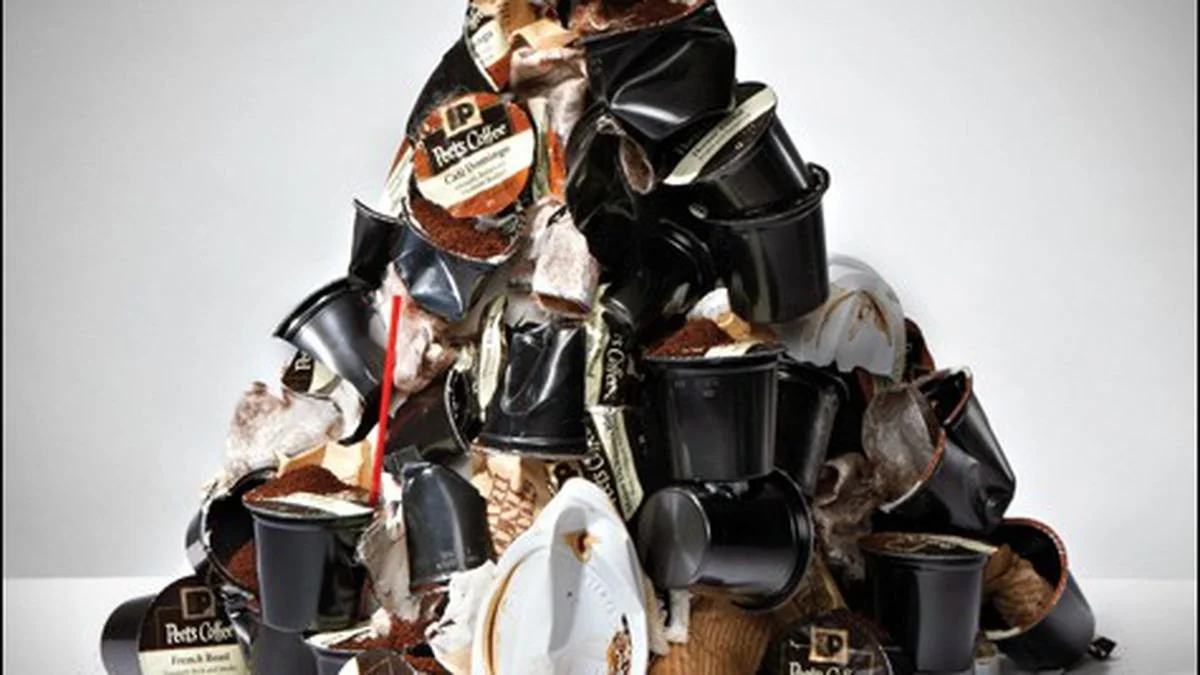How Sustainable is Peet’s Coffee?
I spend a good bit of time at Peet’s coffee nowadays since it’s near my kid’s high school and he walks over there to meet me afterwards. While it’s a comfortable place to work, I see very little about sustainability. So, I decided to dig into their sustainability reports. They seem to be coming out ahead of Starbucks but still have some work to do.
According to their 2024 annual report, every second 4,392 cups of coffee & tea are served by JDE Peet's, with a total of 139 billion cups served!
Peet’s is interesting because they have a non-profit they also run to support sustainability.
“At Peet’s, we are committed to improving conditions in coffee communities around the world. With Enveritas, our non-profit partner, we work to assess conditions on the farms where we source our coffees. Currently, Peet’s supports impact projects in Africa, Central America, South America, and in the Indo-Pacific.”
Peet’s globally uses an extensive amount of resources and generates massive amounts of waste, so finding ways to be sustainable is critical. In 2024 they generated:
6.7 trillion pounds of packaging material using 33% from renewable sources
2,203,268 MWh energy use, enough to power 220,000 homes for a year
1.6 billion gallons of water use, as much as 15,000 homes a year
212 million pounds of waste generated, as much as 32,000 homes a year
How is Peet’s Coffee Sourced?
A cornerstone of JDE Peet’s sustainability strategy is ensuring that its coffee and tea are responsibly sourced. In 2024, the company reported that 84% of its coffee was sourced from verified or certified responsible sources, up from 77% in the prior year. The long-term goal remains 100% responsible sourcing by 2025.
They received their first-ever rating from Ecovadis in the top 1% of 130,000 companies assessed. S&P CSA, a leading ESG ratings provider, upgraded JDE Peet’s ESG rating to the top 95th percentile within the food subindustry.
Green Coffee Sourcing
Peet’s is third-party verified by Enveritas . Verified responsible sourcing builds on the strengths of certification—setting standards for coffee farms—but extends to the entire farm footprint. More importantly, it extends to everyone —including the small-scale producers who produce more than half the world’s coffee. Impactful solutions start with state-of-the-art measurement. With updated technology that combines AI and satellite imagery with on-the-ground surveys, Enveritas executes more than 70,000 sustainability audits per year in Peet’s coffee supply chain alone. More importantly, Peet’s pays for this service rather than passing on the costs to farmers.
In 2024, 92.4% of JDE Peet's green coffee was responsibly sourced.
JDE Peet's unleashes the possibilities of coffee and tea in more than 100 markets with a portfolio of over 50 brands including L’OR, Peet’s, Jacobs, Senseo, Tassimo, Douwe Egberts, Old Town, Super, Pickwick and Moccona.
Farmer Engagement
The company had 73 active projects with smallholder farmers and reached over 134,000 farmers through training programs focused on emissions reduction and climate resilience. Currently, 50% of farmers in their value chain use regenerative agriculture. JDE Peet’s continues to invest in farming communities through training programs, technical assistance, and access to financing. In 2024, over 650,000 farmers received training on sustainable farming practices—addressing soil health, water efficiency, and climate adaptation. A notable initiative is the “Common Grounds” program, which seeks to improve coffee farmer resilience by linking them to climate-smart agriculture tools and diversifying income sources. Despite this, the report acknowledges that farmer incomes in some regions remain volatile due to fluctuating market prices and climate shocks.
Deforestation
The company expanded its fight against coffee-related deforestation by signing Memoranda of Understanding (MOUs) with Peru, Honduras, Rwanda, Burundi, and Vietnam, in addition to existing MOUs with Ethiopia, Papua New Guinea, Tanzania, and Uganda.
How is Peet’s Reducing Its Footprint?
Carbon Emissions
JDE Peet's reduced its Scope 1 & 2 emissions by 31% compared to 2020. They also adopted newly validated near-term and net-zero Science Based Targets initiative (SBTI) goals to further reduce greenhouse gas (GHG) and Forest, Land, and Agriculture (FLAG) emissions by 2030.
JDE Peet’s has set science-based targets to reduce greenhouse gas emissions across its operations (Scope 1 and 2) and value chain (Scope 3). In 2024, operational emissions (Scope 1 and 2) were reduced by 18% compared to the 2020 baseline. Renewable electricity usage reached 92%, a step closer to the 100% renewable target by 2025.
For Scope 3, which makes up the majority of the company’s carbon footprint, emissions intensity declined by 5%—though the report notes that absolute reductions are proving more challenging due to growth in production volumes.
Packaging
79% of the company's packaging is now reusable, recyclable, or compostable. The problem is that many cups don’t actually make it to the recycling or compost facility or it get’s incinerated, releasing chemicals into the air, meaning this is an overblown number. A major innovation was the launch of the world's first fully recyclable paper refill pack for soluble coffee, which reduces packaging material by 97% and decreases CO2 emissions by 71% compared to a plastic refill pack. The paper pack also results in 98% less CO2e emissions than a 200g glass jar. An initiative by the Pickwick brand to remove plastic overwraps in the Netherlands will save 111 tons of plastic globally each year - this is how reductions should occur - at the source.
Packaging waste reduction is tied to the company’s circular economy commitments. In 2024, 85% of packaging was recyclable, reusable, or compostable, moving toward a 100% goal.
JDE Peet’s is working to eliminate unnecessary plastic and increase the use of recycled materials. In 2024, 30% of plastic packaging contained recycled content, up from 23% in 2023. The company rolled out paper-based refill packs for popular coffee products in several European markets, reducing plastic use by up to 97% for those SKUs.
On the product side, innovations like carbon-neutral coffee capsules and plant-based creamers reflect consumer demand for lower-impact products. However, scaling these innovations across global markets remains a challenge.
Energy and Waste
The company's use of renewable electricity remained at 45% of total electricity consumption. They also reduced total energy consumption by 9% in 2024 compared to 2023. They extended the use of on-site solar panels at their Wuxi site in China, with more planned for their Johor site in 2025. The project is designed to cover ~20% of the plant's annual power consumption, delivering 210 MWh of sustainable electricity and reducing CO2e emissions by 1.2kt annually.
Water stewardship remains a priority, especially in manufacturing sites located in water-stressed regions. In 2024, water use efficiency improved by 11% from the 2020 baseline. The company also achieved zero waste to landfill at 92% of its manufacturing sites, with the goal of reaching 100% in 2025.
How Can Peet’s Improve?
While the report celebrates milestones, it also acknowledges gaps:
Scope 3 Emissions
The largest share of JDE Peet’s carbon footprint comes from Scope 3, particularly in the agricultural supply chain. Progress here is slower, and absolute reductions remain elusive.
Farmer Income Volatility
Despite training and support, many coffee farmers still face income instability, driven by market fluctuations and climate change impacts.
Packaging Circularity
Although recyclability rates are high, actual recycling rates vary significantly by region, limiting the real-world impact.
Scaling Innovations
Pilot projects in sustainable packaging and products need to be scaled globally to achieve meaningful impact.
Water Stress Regions
Continued focus is needed in areas where coffee or tea sourcing coincides with high water scarcity.
Deforestation
The company expanded its fight against coffee-related deforestation by signing Memoranda of Understanding (MOUs) with several countries. In 2024, they added Peru, Honduras, Rwanda, Burundi, and Vietnam to their existing list of partners, which includes Ethiopia, Papua New Guinea, Tanzania, and Uganda. These MOUs likely serve as a framework for collaboration to prevent deforestation in coffee-growing regions.
Peet's is engaging directly with smallholder farmers through active projects and training programs. The report notes that they have reached over 134,000 farmers through training focused on emissions reduction and climate resilience. This training likely includes best practices to avoid deforestation and promotes sustainable land use. The report also highlights that 50% of farmers in their value chain are now using regenerative agriculture practices, which can help to restore soil health and reduce the need for expanding farmland into forested area
What Project’s Does Peet’s Fund?
As of December 2024, they have invested in 48 impact projects, 17 of which are active initiatives, ranging from farmer productivity initiatives to clean water access. As a founder of World Coffee Research , they support their innovation of climate-smart coffee plants, because that supports smallholder coffee farmers—those most challenged by shifts in weather and disease. They train farmers via TechnoServe, because knowing how to grow a hyper-productive hybrid is as important as having one.





